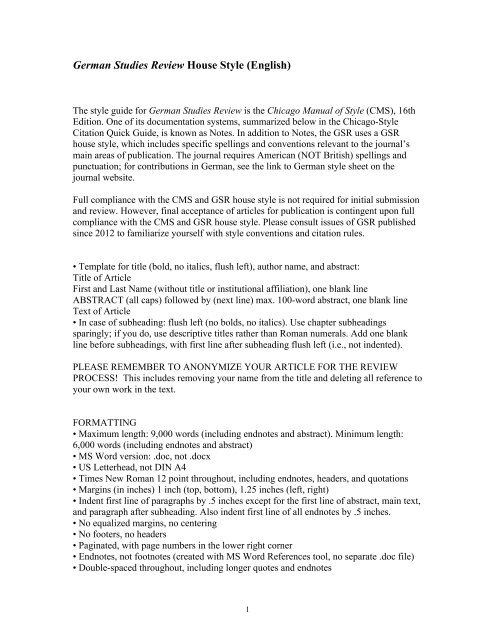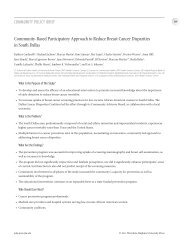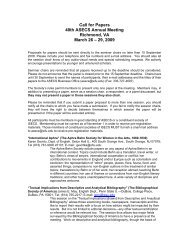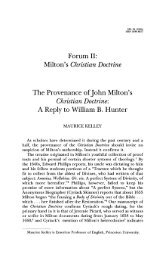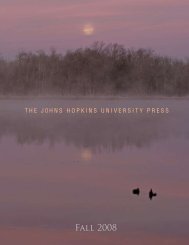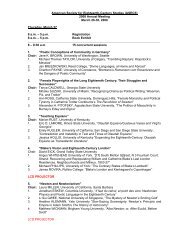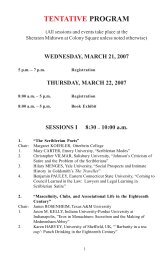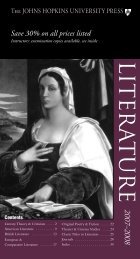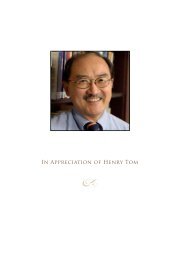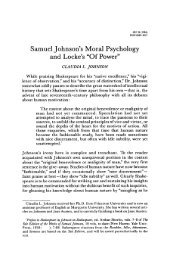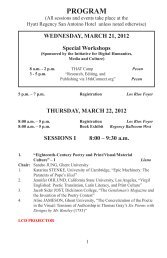German Studies Review House Style (English) - The Johns Hopkins ...
German Studies Review House Style (English) - The Johns Hopkins ...
German Studies Review House Style (English) - The Johns Hopkins ...
You also want an ePaper? Increase the reach of your titles
YUMPU automatically turns print PDFs into web optimized ePapers that Google loves.
<strong>German</strong> <strong>Studies</strong> <strong>Review</strong> <strong>House</strong> <strong>Style</strong> (<strong>English</strong>)<strong>The</strong> style guide for <strong>German</strong> <strong>Studies</strong> <strong>Review</strong> is the Chicago Manual of <strong>Style</strong> (CMS), 16thEdition. One of its documentation systems, summarized below in the Chicago-<strong>Style</strong>Citation Quick Guide, is known as Notes. In addition to Notes, the GSR uses a GSRhouse style, which includes specific spellings and conventions relevant to the journal’smain areas of publication. <strong>The</strong> journal requires American (NOT British) spellings andpunctuation; for contributions in <strong>German</strong>, see the link to <strong>German</strong> style sheet on thejournal website.Full compliance with the CMS and GSR house style is not required for initial submissionand review. However, final acceptance of articles for publication is contingent upon fullcompliance with the CMS and GSR house style. Please consult issues of GSR publishedsince 2012 to familiarize yourself with style conventions and citation rules.• Template for title (bold, no italics, flush left), author name, and abstract:Title of ArticleFirst and Last Name (without title or institutional affiliation), one blank lineABSTRACT (all caps) followed by (next line) max. 100-word abstract, one blank lineText of Article• In case of subheading: flush left (no bolds, no italics). Use chapter subheadingssparingly; if you do, use descriptive titles rather than Roman numerals. Add one blankline before subheadings, with first line after subheading flush left (i.e., not indented).PLEASE REMEMBER TO ANONYMIZE YOUR ARTICLE FOR THE REVIEWPROCESS! This includes removing your name from the title and deleting all reference toyour own work in the text.FORMATTING• Maximum length: 9,000 words (including endnotes and abstract). Minimum length:6,000 words (including endnotes and abstract)• MS Word version: .doc, not .docx• US Letterhead, not DIN A4• Times New Roman 12 point throughout, including endnotes, headers, and quotations• Margins (in inches) 1 inch (top, bottom), 1.25 inches (left, right)• Indent first line of paragraphs by .5 inches except for the first line of abstract, main text,and paragraph after subheading. Also indent first line of all endnotes by .5 inches.• No equalized margins, no centering• No footers, no headers• Paginated, with page numbers in the lower right corner• Endnotes, not footnotes (created with MS Word References tool, no separate .doc file)• Double-spaced throughout, including longer quotes and endnotes1
http://www.abkuerzungen.biz/presse-medien/zeitungen-zeitschriften/ for common<strong>German</strong> newspaper acronyms.• See the section “Commonly Used Words and Phrases” below for further GSR spellingconventions.QUOTATIONS• Use “smart,” not "straight" quotation marks.• For in-text quotations, use double quotes; use single quotes for quotation within aquotation (nested quotes).• Always place commas and periods inside of closing quotation marks (“example,” /“example.”), whether quotation marks are single (‘example,’), double (“example,”), orboth together (“‘example,’”). Colons and semicolons are always outside the closingquotations marks (“example”:). Question marks and exclamation points are also outsideclosing quotation marks unless they are part of the quoted material.• A colon should introduce a quotation of more than one complete sentence; a comma isused to separate an introductory phrase from a quotation of one sentence or less.• Single quotes are only used in nested quotes; whenever words need to be emphasized aswords, please stick to italics. And “scare quotes” are always double quotes and should beused sparingly.A COMMENT ON GERMAN AND ENGLISH QUOTES:In <strong>German</strong>-language texts, include <strong>German</strong> quotes in the <strong>German</strong> original; quote <strong>English</strong>quotes in <strong>English</strong> (not <strong>German</strong> translations). In <strong>English</strong>-language texts, the preference isfor all <strong>German</strong> (or non-<strong>English</strong>) quotes to be translated in the text; do not provide<strong>German</strong> original quotes in the body of the text or in the endnotes. Please provide <strong>English</strong>translations for unfamiliar <strong>German</strong> terms; also provide translations (in parentheses) for allfilmic and literary texts the first time they are mentioned; you may refer to <strong>German</strong>original titles thereafter. Use available <strong>English</strong> translations whenever possible and, ifapplicable, add a statement in the endnotes that all translations are your own.Exception: In the case of close readings and literary analyses, give the <strong>German</strong> originaland provide a translation in parentheses immediately following the quote. In the case ofshort <strong>German</strong> sentences or phrases, they may be included if crucial to the argument butmust be translated; please follow the conventions for longer <strong>German</strong> quotes.Important: If quoting extensively from one literary text, please provide bibliographicalinformation for the first time in endnotes and then include page numbers in parentheses inthe text itself.SUPPLEMENTAL MATERIALPlease also include the following with your original submission:Bio Blurb: submit a 50-word biographical blurb (with e-mail address in parenthesis afteryour name) together with your article. PLEASE INCLUDE IN A SEPARATE FILE. Thiswill appear in a separate Contributors section.Abstract (ENGLISH ONLY): include a 100-word word abstract at the beginning of yourarticle between the title of article and name of author and the main body of text.3
Illustrations: provide illustrations in .TIFF format (larger than 300 DPI) and mark theirposition in the text as follows (on separate line, flush left): . For in-textreferences to illustrations, please format them thus: (Figure 1). Provide captions inseparate file. You are responsible for all copyright-related permissions and fees.Tables: provide tables in separate files, clearly labeled with captions in separate file.Chicago-<strong>Style</strong> Citation Quick Guide(adapted from http://www.chicagomanualofstyle.org/tools_citationguide.html)<strong>The</strong> following examples illustrate citations using the Notes system. Examples of Notesare followed by shortened versions of citations to the same source. For more details andmany more examples, see chapter 14 of <strong>The</strong> Chicago Manual of <strong>Style</strong>.PLEASE NOTE: Do not use ibid. or Ebenda; for examples on how to reference texts forthe first time and thereafter, see 1. and 2. below. Always provide exact range of pagenumbers (i.e., 140-145 instead of 140-45 or 140ff.). Use colons for separating title andsubtitle in <strong>English</strong>-language titles; use periods for this purpose in <strong>German</strong>-language titles.BookOne author1Wolfram Pyta, Hindenburg. Herrschaft zwischen Hohenzollern und Hitler(Munich: Siedler, 2007), 106–109.2Pyta, Hindenburg, 25.Two or more authors1Geoffrey C. Ward and Ken Burns, <strong>The</strong> War: An Intimate History, 1941–1945(New York: Knopf, 2007), 52.2Ward and Burns, War, 159–161.Editor, translator, or compiler instead of author1 Richmond Lattimore, trans., <strong>The</strong> Iliad of Homer (Chicago: University ofChicago Press, 1951), 91–92.2 Stuart Taberner, ed., <strong>The</strong> Novel in <strong>German</strong> since 1990 (Cambridge: CambridgeUniversity Press, 2011), 223–226.3Lyn Marven and Stuart Taberner, eds., Emerging <strong>German</strong>-Language Novelists ofthe Twenty-First Century (Rochester, NY: Camden <strong>House</strong>, 2011), 102–104.4Lattimore, Iliad, 24.5 Taberner, Novel, 36.6Marven and Taberner, Emerging, 102.Editor, translator, or compiler in addition to author1 Gabriel García Márquez, Love in the Time of Cholera, trans. Edith Grossman(London: Cape, 1988), 242–255.2 Wilhelm Dilthey, Briefwechsel, Band I. 1852-1882, ed. Gudrun Kühne-Bertramand Hans-Ulrich Lessing (Göttingen: Vandenhoeck & Ruprecht, 2011), 129–131.3 García Márquez, Cholera, 33.4
4 Dilthey, Briefwechsel, 62–63.Chapter or other part of a book1 Isabel V. Hull, “Military Culture, Wilhelm II, and the End of the Monarchy inthe First World War,” in <strong>The</strong> Kaiser: New Research on Wilhelm II’s Role in Imperial<strong>German</strong>y, eds. Annika Mombauer and Wilhelm Deist (Cambridge: Cambridge UniversityPress, 2003), 236–237.2 William Flesch, “Ancestral Voices: De Man and His Defenders,” in Responses:On Paul de Man’s Wartime Journalism, eds. Werner Hamacher et al. (Lincoln:University of Nebraska Press, 1989), 174–176.3Hull, “Military Culture,” 236.4Flesch, “Ancestral Voices,” 175.Chapter of an edited volume originally published elsewhere (as in primary sources)1 Quintus Tullius Cicero, “Handbook on Canvassing for the Consulship,” inRome: Late Republic and Principate, eds. Walter Emil Kaegi Jr. and Peter White, vol. 2of University of Chicago Readings in Western Civilization, eds. John Boyer and JuliusKirshner (Chicago: University of Chicago Press, 1986), 35.2 Cicero, “Canvassing for the Consulship,” 35.Preface, foreword, introduction, or similar part of a book1 James Rieger, introduction to Frankenstein: <strong>The</strong> Modern Prometheus, by MaryWollstonecraft Shelley (Chicago: University of Chicago Press, 1982), xx–xxi.2 Rieger, introduction, xxxiii.Book published electronicallyIf a book is available in more than one format, cite the version you consulted. For booksconsulted online, list a URL; do not include an access date. If no fixed page numbers areavailable, you can include a section title or a chapter or other reference number.1 Jane Austen, Pride and Prejudice (New York: Penguin Classics, 2007), Kindleedition.2 Philip B. Kurland and Ralph Lerner, eds., <strong>The</strong> Founders’ Constitution (Chicago:University of Chicago Press, 1987), http://press-pubs.uchicago.edu/founders/.3 Austen, Pride and Prejudice.4 Kurland and Lerner, Founder’s Constitution, chap. 10, doc. 19.Journal articlesArticle in a print journalIn a note, list the specific page numbers consulted, if any.1 Wolfgang Hardtwig, “Von Preußens Aufgabe in Deutschland zu DeutschlandsAufgabe in der Welt. Liberalismus und borussianisches Geschichtsbild zwischenRevolution und Imperialismus,” Historische Zeitschrift 231, no. 2 (1980): 265.2 Hardtwig, “Preußens Aufgabe,” 265.Article in an online journal5
Include a DOI (Digital Object Identifier) if the journal lists one. A DOI is a permanent IDthat, when appended to http://dx.doi.org/ in the address bar of an Internet browser, willlead to the source. If no DOI is available, list a URL. Do not include the access date.1 Gueorgi Kossinets and Duncan J. Watts, “Origins of Homophily in an EvolvingSocial Network,” American Journal of Sociology 115 (2009): 411, doi:10.1086/599247.2Kossinets and Watts, “Origins of Homophily,” 439.Article in a newspaper or popular magazineNewspaper and magazine articles may be cited in running text (“As Sheryl Stolberg andRobert Pear noted in a New York Times article on February 27, 2010, . . . ”) instead of ina note. <strong>The</strong> following examples show the more formal versions of the citations. If youconsulted the article online, include a URL; an access date is not required. If no author isidentified, begin the citation with the article title.1 Arthur <strong>Johns</strong>on, “Der Lotse besteigt das Schiff,” Kladderadatsch, 10 May 1925,1.2“<strong>German</strong>ic Museum Opens,” <strong>The</strong> Harvard Crimson, 26 February 1921,http://www.thecrimson.com/article/1921/2/26/germanic-museum-opens-pthe-germanicmuseum/.3 <strong>Johns</strong>on, “Lotse,” 2.4“<strong>German</strong>ic Museum.”Book review1 David Kamp, “Deconstructing Dinner,” review of <strong>The</strong> Omnivore’s Dilemma: ANatural History of Four Meals, by Michael Pollan, New York Times, 23 April 2006,Sunday Book <strong>Review</strong>, http://www.nytimes.com/2006/04/23/books/review/23kamp.html.2 Kamp, “Deconstructing Dinner.”<strong>The</strong>sis or dissertation1 Mihwa Choi, “Contesting Imaginaries in Death Rituals during the NorthernSong Dynasty” (PhD diss., University of Chicago, 2008).2 Choi, “Contesting Imaginaries.”Paper presented at a meeting or conference1 Rachel Adelman, “‘Such Stuff as Dreams Are Made On’: God’s Footstool in theAramaic Targumim and Midrashic Tradition” (paper presented at the annual meeting forthe Society of Biblical Literature, New Orleans, Louisiana, 21–24 November 2009).2 Adelman, “Such Stuff as Dreams.”WebsiteA citation to website content can often be limited to a mention in the text or in a note(“As of July 19, 2008, the McDonald’s Corporation listed on its website . . . ”). If a moreformal citation is desired, it may be styled as in the examples below. No access date isrequired. If necessary, include a date when the site was last modified. PLEASEREMOVE ALL HYPERLINKS.1 “Google Privacy Policy,” last modified 11 March 2009,http://www.google.com/intl/en/privacypolicy.html.6
2 “McDonald’s Happy Meal Toy Safety Facts,” McDonald’s Corporation,http://www.mcdonalds.com/corp/about/factsheets.html.3 “Google Privacy Policy.”4“Toy Safety Facts.”Blog entry or commentBlog entries or comments may be cited in running text instead of in a note (“In acomment posted to <strong>The</strong> Becker-Posner Blog on February 23, 2010, . . .”). <strong>The</strong> followingexamples show the more formal versions of the citations. <strong>The</strong>re is no need to add pseud.after an apparently fictitious or informal name. No access date is required.1 Jack, 25 February 2010 (7:03 p.m.), comment on Richard Posner, “DoubleExports in Five Years?,” <strong>The</strong> Becker-Posner Blog, 21 February 2010,http://uchicagolaw.typepad.com/beckerposner/2010/02/double-exports-in-five-yearsposner.html.2 Jack, comment on Posner, “Double Exports.”E-mail or text messageE-mail and text messages may be cited in running text (“In a text message to the authoron March 1, 2010, John Doe revealed . . . ”) instead of in a note. <strong>The</strong> following exampleshows the more formal version of a note.1 John Doe, e-mail message to author, 28 February 2010.Films and television programsFilms should be quoted in the texts, based on the following format:Original Title (<strong>English</strong> Title if applicable, Name of Director, Year of Release).PLEASE NOTE: In case of existing <strong>English</strong> release titles, use the ones listed on IMDb; inall other cases, translate but do not italicize.IMPORTANT:For book citations, please only provide the first city of publication. In the case of<strong>German</strong>-language publishers, do not include the word “Verlag” (e.g., “Fischer,” not“Fischer Verlag”); the same rule applies for <strong>English</strong>-language publishers (e.g.,“Schocken,” not “Schocken Books”). However, write out the names of university presses(e.g., “Yale University Press,” not “Yale UP”). Please anglicize names of well-knowncities (Cologne, Munich, Rome). Provide the postal abbreviation for US states if suchclarification is necessary: e.g., “Cambridge, MA: Harvard University Press” but not“New York, NY: Columbia University Press”; “Garden City, NY: Doubleday” but not“Bloomington, IN: Indiana University Press” (since the press name already identifies thestate).7
Commonly Used Words and Phrases(based on Chicago Manual of <strong>Style</strong>, especially 7.90 (Hyphenation Guide for Compounds,Combining Forms, and Prefixes), 8.65 (Lowercased Words Derived from Proper Nouns),8.66-8.76 (Names of Organizations), and 8.77-8.93 (Historical and Cultural Terms)• 50 percent; a 10 percent increase (no hyphen)• the 1990s (no apostrophe); the nineties• 1920s-style (both adjective and adverb take hyphen)• African Americans; African American history• the Bible; biblical• Chancellor Adenauer; the chancellor• the church today; the United Methodist Church (denomination); a Methodist church• the Communist Party (but Communist parties); the party; Communist(s); Communistcountries; communism or socialism (as a system of thought) but Communism or SocialDemocracy (as the name of an international political movement)• cutting-edge research; on the cutting edge• decision making; a decision-making body (but policymaking and policymaker)• the East, eastern, an easterner, the East Coast (referring to the eastern US); the East, theFar East, Eastern (referring to the Orient and Asian culture); eastern Europe, but EasternEurope when referring to the post-WWII division of Europe• federal; the federal government; federal agencies• a half hour; a half-hour session• a historical study; an heir (use “a “ before a pronounced “h “)• a history course (lowercase academic subjects unless they are part of a department nameor an official course name or are themselves proper nouns, such as <strong>German</strong> <strong>Studies</strong> or<strong>German</strong> Cultural <strong>Studies</strong>)• the Ice Age, but the information age (capitalize prehistoric cultural periods but notanalogous terms for modern periods)• the Internet; the Net• John A. Doe Jr.; John A. Doe III (no commas)• L. A. Lane (period and space after initials); LBJ (no period or space when whole nameabbreviated)• a master’s degree; MA’s and PhD’s• the Middle Ages• the middle class; a middle-class neighborhood• New York City; the city of New York• the nineteenth century; nineteenth-century history; early nineteenth-century history• North Africa, North African countries, in northern Africa• one-half (noun and adjective)• the Pacific Ocean; the Pacific and Atlantic oceans• Parliament; parliamentary; the British parliament• the pope; Pope John Paul II• the professor; Kristen Lindenmeyer, professor of history; Professor Lindenmeyer• Qur’an; Qur’anic (or Koran; Koranic)• the Republic of Indonesia; the republic• the Right (and the Left), but rightwing and leftwing parties8
• southern Africa (referring to the southern part of the continent), but Southern California(considered a cultural entity)• ten- and twenty-year intervals (hyphen with word space)• toward, not towards• the twenty-first century• Northwestern and Harvard University but Northwestern and Harvard universities.PLEASE NOTE: <strong>German</strong> universities should be Anglicized in <strong>English</strong>-language texts(Free University of Berlin)• US and USA, not U.S. and U.S.A. (same for UK)• the West (and the East), Western civilization, West European countries, but southernstates (geographically) and northern migration• World War I or II, not First or Second World War• the World Wide Web; the web; a website; a web page9
GUIDELINES FOR BOOK REVIEWERSPlease use the following format for the book title, with the following information:Name of Book. By Author (or: Edited by Coeditor, Coeditor, and Coeditor). Place ofPublication: Publisher, Year of Publication. Pp. Number of Pages. Paper or Cloth Price.ISBN.Examples:Behind the Berlin Wall: East <strong>German</strong>y and the Frontiers of Power. By PatrickMajor. Oxford: Oxford University Press, 2010. Pp. xii + 321. Paper $45.00. ISBN978-0199605101.Zwischen Mignon und Lulu. Das Phantasma der Kindsbraut in Biedermeier undRealismus. Edited by Malte Stein, Regina Fasold, and Heinrich Detering. Berlin:Erich Schmidt, 2010. Pp. 330. Cloth €48.90. ISBN 978-3503122196.Please note:--provide only the first place of publication, not several; anglicize place name--provide the name of the US state (postal abbreviations) if the cities are not major cities(e.g., Rochester, NY: Camden <strong>House</strong>) and/or if the name of the press does not indicatethe state (as is the case with university presses, e.g.,: Austin: University of Texas Press)--provide the 13-digit ISBN number, NOT the 10-digit ISBN number--provide price for US books in $, British books in £, European books in €, and so forth,always using a period to separate dollar/pound/euro.etc. and cents.--use colons for separating title and subtitle in <strong>English</strong>-language titles; use periods for thispurpose in <strong>German</strong>-language titles--please review the general GSR style guide and the Chicago Manual of <strong>Style</strong>, 16 thEdition, for further spelling and punctuation conventionsGive your name as follows (flush right):First and Last Name, Name of InstitutionPlease note: anglicize the names of universities, colleges, and foundations in yourinstitutional affiliation, e.g., Free University Berlin, University of Lausanne, FriedrichEbert Foundation. In all other cases, use the proper name: Bundesarchiv Berlin, etc.10


